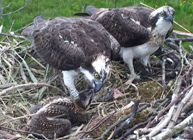Tracking the osprey

Feeding the young osprey.
12 July 2012
Aberystwyth University’s Institute of Biological, Environmental and Rural Sciences (IBERS) is collaborating with Montgomeryshire Wildlife Trust’s Dyfi Osprey Project in working to re-establish an osprey population on the Dyfi Estuary in Mid-Wales.
Professor Wayne Powell, Director of IBERS, this week announced sponsorship of solar-powered GPS trackers, enabling researchers to study the birds’ annual migrations between Wales and West Africa.
Professor Powell said “We are delighted to be supporting Montgomeryshire Wildlife Trust and assisting with their exciting conservation project. This partnership will provide IBERS and its students with great research opportunities now and in the future, and Aberystwyth University welcomes this chance to make a positive contribution to environmental conservation.
“Scientists will initially conduct migration and dietary studies; with DNA and genetic analysis another research area currently under development. In future, there is potential to use the Cors Dyfi Nature Reserve as an outdoor learning and teaching resource for university students.”
Vicky King, a full-time research project coordinator at IBERS, and regular volunteer with the Dyfi Osprey Project, explains “Within the next couple of days the 2012 osprey chick will be ringed and fitted with a GPS tracker. The unit has an operational life of approximately five years transmitting regular location and flight pattern data, enabling us to follow the bird through several migrations.
“Learning more about osprey behaviour and migration routes, their stop-over locations and wintering grounds will enable conservationists to better protect them. GPS tracking will also help us understand the first return migration of immature birds and how they locate back to the UK and choose future nest sites. This is an exciting long-term research project that will contribute greatly towards future conservation efforts.”
Welcoming IBERS’ support, Dyfi Osprey Project Manager Emyr Evans said “Working in partnership with our local university will allow the Montgomeryshire Wildlife Trust to develop and progress our learning and understanding of these magnificent raptors that were, until recently, extinct in Wales.
“By applying Aberystwyth University's expertise in processing the scientific data that will become available as a result of our partnership, we hope to gain invaluable and cutting-edge information about osprey ecology and migration that will ultimately aid in their conservation and recovery in Wales and beyond.”
Two IBERS students have already started their research projects; one looking at juvenile osprey migration routes; the second investigating how environmental conditions influence osprey prey choice.
This isn’t the first time IBERS has worked with the Wildlife Trust. Earlier this year students from the department helped lay almost one kilometre of fibre-optic armoured cable from the visitor centre to the osprey nest, enabling live-streaming of high definition video, audio and scientific data for the first time.
History of Ospreys in the UK
Ospreys, once widespread throughout Wales and most of Britain, were hunted to extinction in the UK 100 years ago. In the mid-1950s they began to recolonize remote areas of Scotland. Following a successful translocation project by Leicestershire and Rutland Wildlife Trust, starting in 1996 the English population also began to grow. This was to prove crucial to the Welsh osprey population. In 2011 a female osprey from Rutland arrived on the Dyfi Estuary and paired with the resident male, resulting in three chicks being born on the estuary for the first time in over 400 years.
History of Ospreys in Wales and on the Dyfi Estuary
• Ospreys have passed over the Dyfi Estuary on migration for many years
• 2007, MWT erect an artificial nesting platform at Cors Dyfi Nature Reserve
• Nesting platform occupied every year since installation, no breeding until 2011
• 2011, male takes possession of Dyfi nest, and pairs with female from Rutland; her parents were part of the translocation project
• 2011, ospreys breed on the Dyfi Estuary for the first time in over 400 years
• 2011, three chicks reared, all successfully migrate to African wintering grounds
• 2012, same adults return to the Dyfi, 3 eggs laid, all hatch, 2 chicks die due to extreme weather conditions



